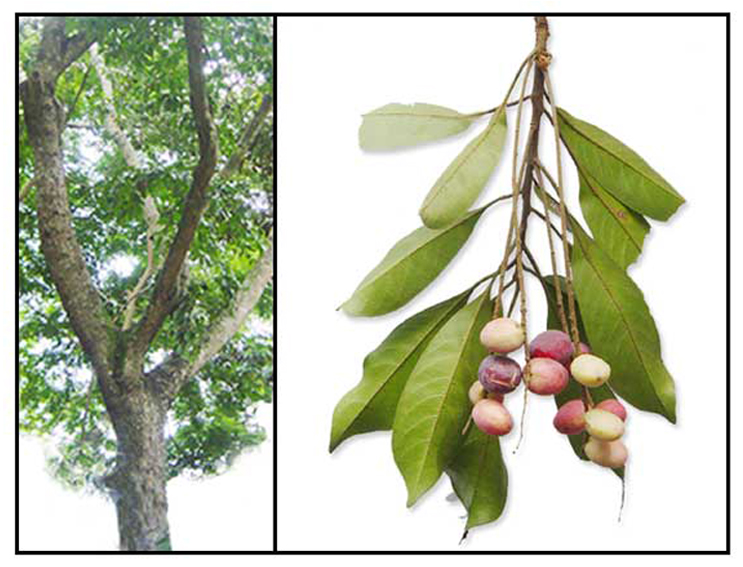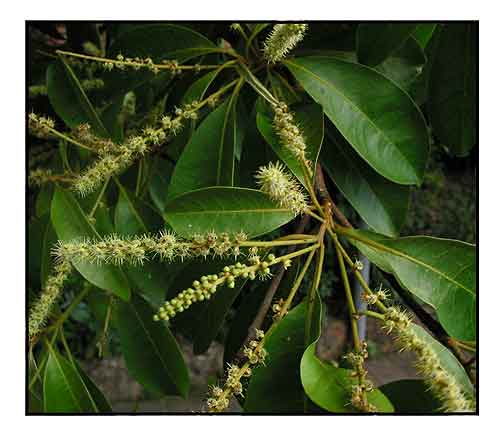 Gen info Gen info
- Terminalia microcarpa is a tree species in the family Combretaceae.
- It
was formally described in 1834 by French botanist Joseph Decaisne.
-
Although not accepted by all in herbaria, many now consider Terminalia sericocarpa as synonymous with Terminallia microcarpa. (9)
Botany
Kalumpit is a tree growing
to a height of 25 meters and a diameter of 1 meter. Bark is black, hard, and fissured. Leaves are
6 to 15 centimeters long, smooth, and pointed at both ends. Flowers are
small, yellowish-white, on slender spikes growing from the axil
of the leaves. Fruit is about 3 to 5 centimeters wide, smooth, and dark red when
ripe, fleshy and sour.
 Distribution Distribution
- Native to the Philippines.
-
Very common and widely distributed
in primary forests at low altitudes from northern Luzon to southern Mindanao.
- Also native to Australia, Bismark Archipelago, Borneo, Jawa, Lesser Sunda Is., Maluku, New Guinea, Northern Territory, Queensland, Solomon Is., Sulawesi, Sumatera.
Constituents
- Bark contains tannin, 42%.
- Study of dichloromethane extract of air-dried leaves isolated squalene (1) lutein (2), and fatty alcohols. (2)
- Phytochemical screening of leaves yielded alkaloids, flavonoids, steroids/terpenoids, gallic tannins and cathecic tannins.
(3)
- Qualitative analysis of ethanol extract of leaves yielded glycosides, flavonoids, saponins, phytosterols, and tannins. (see study below)
Properties
- Tree is a source of nectar for insects and birds.
- Studies have suggested
anti-inflammatory, cytotoxic, anticancer, larvicidal, antioxidant properties.
Parts
used
Fruit, leaves.
Uses
Edibility / Nutritional
- Fruit are edible, eaten raw or made into preserves.
- Fruit has a thin flesh which is sucked from the seed.
- Used to
sweeten and age lambanog (coconut liquer); also, used for making wine.
Folkloric
- Fruit is used in
eyewashes as the fruit of aroma – Acacia farnesiana.
- Fruit lotion also used in humid herpetism or eczema.
Others
- Tannin: Used for making tannin extract or for direct use in leather tannery.
- Fodder: Leaves used as cattle fodder.
- Wood: Used for light construction.
Studies
• α-Glucosidase Inhibition: In a study of Terminalia species for α-glucosidase inhibitory activity, T. microcarpa showed an IC50 value of 25.15 ± 0.04 µg mL-1, compared to Terminalia kaerbacchii with the most active inhibition with 0.27 ±0.17 µg/ml. The reference compound, 1-deoxynojirimycinm, has an IC50 value of approximately 5 µg mL. (3)
• Constituents / Squalene: Dichloromethane extract of air-dried leaves yielded squalene, lutein, and fatty alcohols. Previous studies have shown squalene to significantly suppress colonic ACF formation and crypt multiplicity suggesting chemopreventive activity against colon carcinogenesis. It has also shown cardioprotective effect related to inhibition of lipid accumulation via hypolipidemic and antioxidant mechanisms. (2)
• Cytotoxicity on Human Cancer Cell Lines / Anti-Inflammatory / Fruit: Study evaluated the phytoconstituents of crude dichloromethane (DCM) extract from fruit pulp. The DCM extract exhibited cytotoxic effects against MCF-7 breast cancer cells, HeLa cervical cancer cells, H69PR lung cancer cells, and VCaP prostate cancer cells with IC50s of 2.385, 3.228, 3.732, 8.373 µg/mL respectively. The DCM induced upregulation of early apoptotic genes cfos and cjun transcripts, downregulation of proinflammatory cytokines IL-1ß and TNF-α transcripts in LPS-treated phorbol myristate acetate (PMA)-induced macropahge. Results suggest cytotoxicity to cancer cell lines and anti-inflammatory effect against LPS-induced macrophages. (6)
• Optimization of Antioxidant Extraction / Fruits: Study reports on the effects of extraction parameters on DPPH radical scavenging activity of kalumpit. Temperature, S/S ration, and ethanol concentration exhibited significant effects on DPPH radical scavenging activity of the fruit extract, with a maximum desirability value of 0.977 and predicted % DPPH and ABTS radical scavenging activities of 66.63 and 82.14, respectively. Results suggest the models used were adequate in describing the relationship between factors and response. (7)
• Larvicidal against Aedes aegypti / Leaves: Study evaluated the effect of crude ethanolic extract of Terminalia microcarpa leaves on Aedes aegypti larvae mortality. Qualitative analysis of leaves yielded glycosides, flavonoids, saponins, phytosterols, and tannins. Complete larval mortality was achieved at 5% v/v concentration, with larval mortality at 24 and 48 h postexposure at 46.67% and 86.67%, respectively. The LD50 and LC90 at 24 h post-exposure was 1.03% v/v and 1.59% v/v concentration, respectively. Results suggest potential as larvicide against A. aegypti mosquito larvae. (8)
Availability
Wild-crafted.
|

![]()

